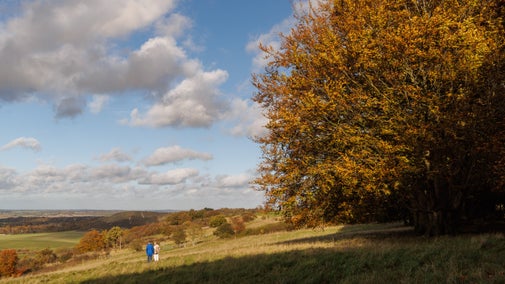Hatfield Forest tree walk
Essex, Bedfordshire & Hertfordshire
Discover ancient oaks, mighty cedars, and special saplings on this gentle circular stroll through Hatfield Forest. The forest is a site of historical and ecological importance and with good reason. It's home to trees of all kinds and ages. This family-friendly trail passes a 1000-year-old maple, a huge cedar that was planted in the 18th century, and an area of reseeded scrub, which is being restored in the vision of the famous landscape gardener Capability Brown.
Near to
Hatfield ForestStart point
Hatfield Forest main entrance car park, Hatfield Forest Road, CM22 6NE. Grid ref: TL547202Trail information
More near here
Hatfield Forest walk
An easy 1.7-mile circular walk through the ancient woodlands at Hatfield Forest, a Site of Special Scientific Interest and National Nature Reserve.

Takeley to Wall Wood circular walk
Explore the idyllic Essex countryside with this 9.5-mile (15.3km) walk from the old railway station in Takeley to the ancient Wall Wood, and back again.

Hatfield Forest buttercup walk
In May and June, the plains at Hatfield Forest are turned into a sea of gold by over 300 million buttercups. It's the perfect time to enjoy this 3.4-mile walk.

Hatfield Forest and Flitch Way walk
Enjoy the splendour of a medieval hunting forest, passing through ancient trees on the Hatfield Forest and Flitch Way walk.

Get in touch
Bush End Road, Takeley, Bishop's Stortford, Essex, CM22 6NE
Our partners

We’ve partnered with Cotswold Outdoor to help everyone make the most of their time outdoors in the places we care for.
You might also be interested in
Walking
Explore some of the finest landscapes in our care on coastal paths, accessible trails, woodland walks and everything in between. Find the best places to walk near you.

Walking in Essex, Bedfordshire and Hertfordshire
From long forest wanders to a gentle amble to a famous literary hut, these are some of the best walks around Essex, Bedfordshire and Hertfordshire.

Cotswold Outdoor: our exclusive walking partner
Learn about the National Trust’s ongoing partnership with Cotswold Outdoor. Find out how they help us care for precious places and the exclusive discount available for National Trust supporters.

Staying safe at National Trust places
The special places in National Trust care sometimes come with a few risks for visitors, be it coastline or countryside. Find out how to keep safe throughout your visits.

Follow the Countryside Code
Help to look after National Trust places by observing a few simple guidelines during your visit and following the Countryside Code.

Outdoor activities at Hatfield Forest
Discover a range of outdoor activities at Hatfield Forest in Essex. From short to long walks, running routes, horse riding and fishing, there's something for everyone.

Family-friendly things to do at Hatfield Forest
Discover what there is to do for families at Hatfield Forest, including spaces to explore and activities to keep kids entertained.

History of Hatfield Forest
Find out about some of Hatfield Forest's rich and varied history, including how the original royal hunting forest was created and then, later, how Lancelot 'Capability' Brown left his mark.



